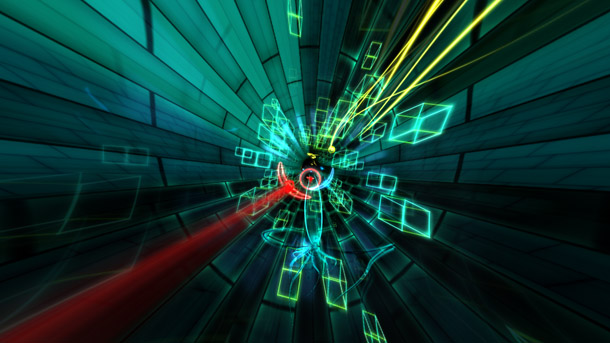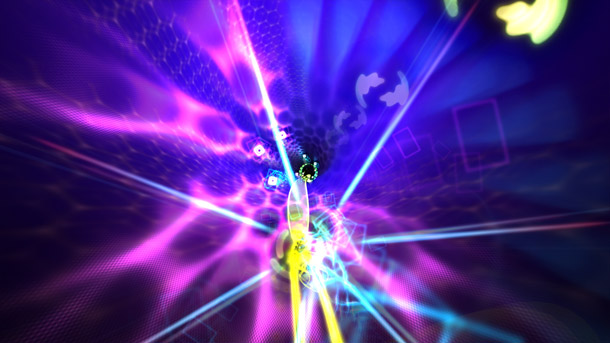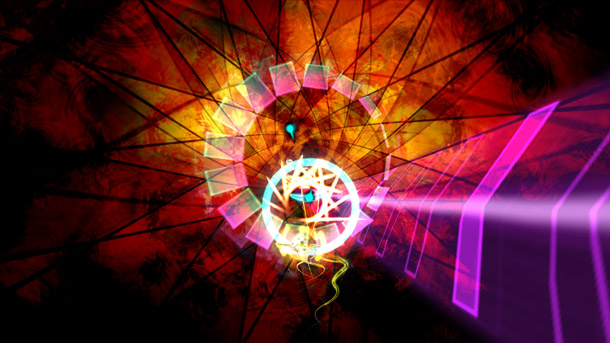Dyad has been in development for 12 years, even if creator Shawn McGrath hasn’t been working on it that long. Look at early music games like Frequency: the player is presented with a music track and moves a cursor around a tube, hitting buttons in sync with notes that fly towards the screen. The music is in control of the gameplay. Then in 2005, Gutar Hero came out and disguised that same gameplay in a guitar. While GH may have given the illusion that the player has control over the music, gameplay was still very much dictated by the notes on the screen. Dyad, while not necessarily a music game, feels like a return to music gaming’s roots. But rather than create another experience where the player blindly follows some preset pattern on the screen, the music takes a backseat and is shaped by the player’s actions.
It makes room for an experience that is challenging and engaging, but also hypnotic and even soothing.

Dyad‘s brilliance lies in its ability to disguise simplicity as complexity. The main menu offers little to no explanation, with options along the side of the screen labeled in TeV, which after a quick Google search I assume stands for teraelectron volts. Selecting one of those presents a list of levels, each with their own objectives, all of which are centered around the concept of hooking.
Hooking refers to lining yourself up with enemies and grabbing onto them, which pulls the player further down the tube, usually to try and beat a set time limit. It’s not a good idea to button mash however, because a speed boost is your reward for hooking two like enemies in a row. (In fact, the word “dyad” in music refers to a set of two notes or pitches.) In the beginning, Dyad will only throw enemies of a couple of different colors at you, just enough so that you have to be careful which ones you hook if you want to beat the target time. Later on, you’ll be facing four or five different types of enemies, making the choice which ones to hook a lot more difficult, as you’ll want to nab as many boosts as possible.
It’s not all hooks and giggles, though. About five or six levels in, the concepts of grazing and lancing are introduced. Grazing refers to passing dangerously close to an enemy that you have previously hooked. Doing so will fill your lance meter up a little. Once that meter is filled, you can press square to dash full speed ahead, smashing through enemies as you please. Running enemies through while lancing keeps your speed up and hitting a special “lance extender” enemy will keep your lance going while simultaneously refilling your meter. Even then, lancing is not a free ride; hitting certain enemies will actually cancel out your lance alltogether and slow you down significantly. Dyad takes these mechanics and twists them in each level, giving you different objectives to keep you on your toes. In one level, you may be racing to beat a section within a certain time limit, while in another you may be asked to survive as long as possible on limited health. Still others offer more difficult challenges like telling you to hook 22 pairs of enemies but only allowing you to press the button 50 times. After completing a level, you have the option to go through it again with special objectives for a trophy or to play the level in Remix mode, allowing you to set a number of different modifiers before you play.

Dyad‘s relatively simple mechanics are tied together by some of the most ingenious sound design in recent memory. As I said before, while Dyad is not a music game in the traditional sense, it owes a lot of itself to the genre and could do what it does so well without such a quality soundtrack behind it. The background music provides the basic track and every action the player takes adds an irregular instrument, not unlike idle wind chimes. It creates a calming atmosphere that is extremely condusive to games like Dyad, allowing the player to enter a zen-like state, thinking of nothing but the task at hand. It’s also why I would spend four hours on it in a single sitting without realizing.
That’s not to imply that Dyad is so easy that you can zone out entirely. Quite the opposite! Expect Dyad to put your reflexes through their paces as the difficult ramps up significantly. As I’m writing this, I have only made it through the first two groups of levels despite investing nearly six hours. While it’s entirely possible that I might just be bad, it’s a sign that Dyad will stay challenging for many more hours to come. Unfortunately, there are times where I felt like the difficulty was a tad artificial and possibly even unintentional. That’s mostly due to Dyad‘s visuals.
Dyad is gorgeous, don’t get me wrong. The problem is that a couple of the visual effects it uses to look so gorgeous can actually get in the player’s way. One of those is motion blur, which makes it hard to differentiate between enemy colors in some of the levels with more flashy backgrounds. The other is the light bloom around enemies and the player which causes them to bleed together at close range. In a game where one of the core mechanics is centered around passing as close to an enemy as possible, that can be a problem. Still, these turn out to be only minor issues that can easily be worked around.
While it may be easy to write Dyad off at first glance as another music game, it’s important to remember that it’s so much more. It successfully takes that genre and molds it into something different entirely. It’s a reminder that there are still musically-focused games to be made that require you to do more than just repeat a series of notes explicitly. Dyad will suck you in with it’s beautiful visuals and engaging soundtrack, and then it will promptly betray you with it’s challenging but fair gameplay. It’s the type of game that can turn one more level into five more before you realize it and should not be missed when it releases on PSN this Tuesday.
This review based off a downloadable copy of the game provided by the developer. Also, the reviewer wanted to make a joke about how his Dyad was never around growing up but there just wasn’t a good place for it. Sorry.


No Comments